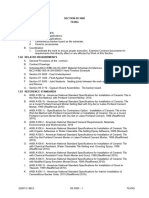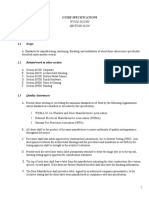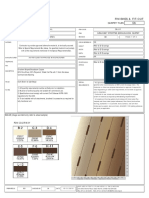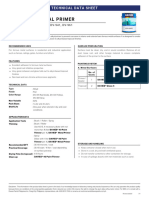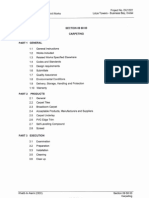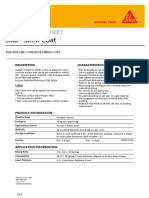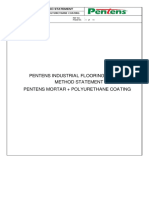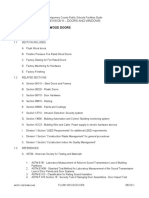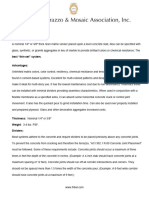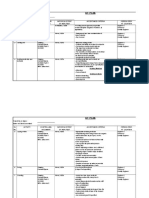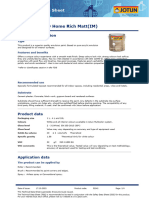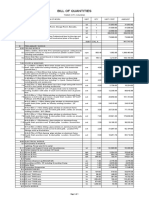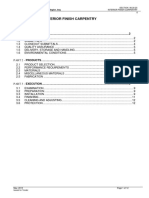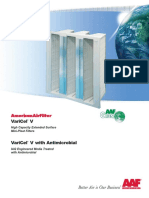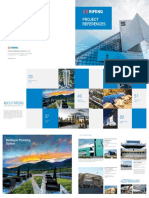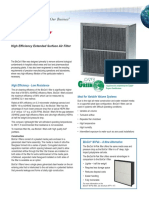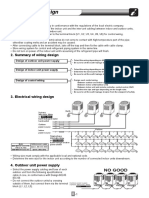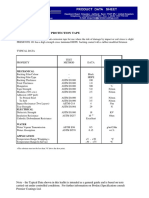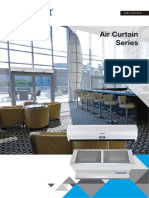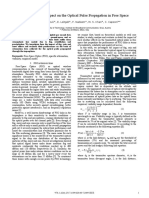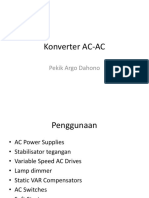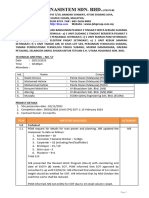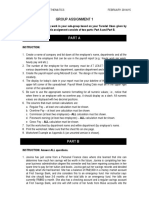Section 09310 Ceramic Tile Part 1 - General
Uploaded by
Im ChinithSection 09310 Ceramic Tile Part 1 - General
Uploaded by
Im ChinithANZ Royal Bank (Cambodia) LTD.
Mao Tse Tung Blvd Branch
Construction New Building June 2008
SECTION 09310
CERAMIC TILE
PART 1 - GENERAL
1.1 SUMMARY
A. This section includes, but is not limited to, the following:
1. Unglazed ceramic tile for floors.
2. Glazed ceramic tile for walls.
B. Related requirements specified elsewhere:
1. Concrete subfloors (Section 03300 CAST-IN-PLACE CONCRETE).
2. Cement - Based waterproof coating (Section 07180 CEMENT - BASED
WATERPROOF COATING)
3. Raised flooring (Section 10270 ACCESS FLOORING).
4. Toilet accessories (Section 10800 TOILET ACCESSORIES).
5. Floor drains (Division 15 MECHANICAL).
1.2 REFERENCES
A. Foreign standards are referenced as they support the indicated design intent.
Alternate standards may be proposed for consideration by the Architect. The
Architect shall be the sole judge as to whether the proposed standards
adequately support the indicated design tent.
B. The work is subject to applicable portions of the following standards:
1. ANSI A108.1 "Installation of Glazed Wall Tile, Ceramic Mosaic Tile,
Quarry Tile and Paver Tile Installed with Portland Cement Mortar",
American National Standards Institute.
2. ANSI A108.5 "Installation of Ceramic Tile with Dry-Set Portland
Cement Mortar or Latex-Portland Cement Mortar", American National
Standards Institute.
File: ANZ-SP-MTB 2007
ANZ Royal Bank (Cambodia) LTD. Mao Tse Tung Blvd Branch
Construction New Building June 2008
3. ANSI AI08.1O "Installation of Grout in Ceramic Tile Installations",
American National Standards Institute.
4. ANSI AIl8.1 "Specifications for Dry-Set Portland Cement Mortar",
American National Standards Institute.
5. ANSI AIl8A "Specifications for Latex-Portland Cement Mortar",
American National Standards Institute.
6. ANSI A1l8.6 "Specifications for Ceramic Tile Grouts", American
National Standards Institute.
7. ANSI A137.1 "Specifications for Ceramic Tile", American National
Standards Institute.
8. ASTM A 82 "Specification for Steel Wire, Plain, for Concrete
Reinforcement", American Society for Testing and Materials.
9. ASTM A 185 "Specification for Steel Welded Wire, Fabric, Plain, for
Concrete Reinforcement", American Society for Testing and Materials.
10. ASTM C 627 "Method of Evaluating Ceramic Floor Tile Installation
Systems", American Society for Testing and Materials.
11. TCA "Handbook For Ceramic Tile Installation", Tile Council of
America, Inc.
12. TIS, "Thai Industrial Standard".
1.3 PERFORMANCE REQUIREMENTS
A. Load-bearing performance: for ceramic tile installed on walkway surfaces,
provide installations rated for the following load-bearing performance level
based on testing assemblies according to ASTM C 627 that are representative
of those indicated for this Project:
1. Heavy: passes cycles 1 through 12.
1.4 SUBMITAILS
A. Submit manufacturer's product data with application and installation instructions
File: ANZ-SP-MTB 2007
ANZ Royal Bank (Cambodia) LTD. Mao Tse Tung Blvd Branch
Construction New Building June 2008
for all products in accordance with SECTION 01300 SUBMITTALS. Product
data shall include certifications and test reports necessary to show compliance
with the Contract Documents.
1. Master grade certificates for each shipment, type, and composition of tile,
signed by the tile manufacturer and installer.
B. Submit the following samples in accordance with Section 01300 SUBMITTALS:
a. Each type, color, and pattern of tile, grouted, 600 x 600mm panel on
cement backer board.
C. Submit the following shop drawings in accordance with SECTION 01300
SUBMITTALS:
1. Shop drawings indicating ceramic tile patterns and locations and widths
of expansion, contraction, control, and isolation joints in tile substrates
and finished tile surfaces. Show installation details at special conditions.
2. Precisely locate each joint and crack in tile substrates by measuring in the
field, recording measurements on shop drawings, and coordinating them
with tile joint locations, in consultation with the Engineer.
D. Submit test reports indicating compliance of tile materials with specified
requirements and with performance indicated in the supplier's published literature.
E. Submit maintenance schedules in accordance with Section 01700 CONTRACT
CLOSEOUT.
1.5 QUALITY ASSURANCE
A. Before starting the work, arrange a pre-construction meeting with the Architect,
the Contractor, installer, and manufacturer to discuss construction procedures,
specifications, surface readiness, application, material storage and protection, and
additional installer training. Conduct meeting in accordance with SECTION
01200 PROJECT MEETINGS.
B. Source limitations for tile: obtain each color, grade, finish, type, composition, and
variety of tile from one source with resources to provide products from the same
File: ANZ-SP-MTB 2007
ANZ Royal Bank (Cambodia) LTD. Mao Tse Tung Blvd Branch
Construction New Building June 2008
production run for each contiguous area of consistent quality in appearance and
physical properties without delaying the Work.
C. Single-source responsibility for waterproofing membrane and setting and grouting
materials: obtain ingredients of a uniform quality from one manufacturer for each
cementitious and admixture component and from one source or producer for each
aggregate. Materials shall be nonflammable and water cleanable.
D. Installer qualifications: engage an experienced installer who has successfully
completed tile installations similar in material, design, and extent to that indicated
for Project.
1.6 DELIVERY, STORAGE, AND HANDLING
A. Materials shall be delivered to the project site in the manufacturer's original
packaging with brand and name clearly identified. Comply with requirement of
ANSI A137.1 for labeling sealed tile packages. Comply with manufacturer's
instructions for storage and handling. Site dilutions of liquid admixtures will not
be permitted.
B. Prevent damage or contamination to materials by water, freezing, foreign matter,
and other causes.
1.7 PROJECT CONDIDONS
A. Maintain environmental conditions and protect work during and after installation
to comply with referenced standards and manufacturer's printed recommendations.
B. Vent temporary heaters to exterior to prevent damage to tile work from carbon
dioxide buildup.
1.8 WARRANTY
A. Submit a written warranty, executed by the Contractor, installer, and tile
manufacturer, for work under this section for 2 years in accordance with
GENERAL CONDITIONS.
The warranty shall be in addition to and not a limitation of other rights which the
Owner may have against the Contractor under the Contract Documents.
File: ANZ-SP-MTB 2007
ANZ Royal Bank (Cambodia) LTD. Mao Tse Tung Blvd Branch
Construction New Building June 2008
A. Submit a written warranty, executed by the manufacturer of installation systems,
adhesives, mortars, and grouts, for work under this section for 10 years in
accordance with GENERAL CONDITIONS. The warranty shall cover
replacement materials and labor costs for demolition, tile accessories, and
installation systems. The warranty shall be in addition to and not a limitation of
other rights which the Owner may have against the Contractor under the Contract
Documents.
B. Repairs and replacements made under the warranty shall bear an additional
warranty of 1 year or longer period standard with the manufacturer.
1.9 MAINTENANCE INSTRUCTION
A. Provide instruction in the maintenance of tile materials in accordance with Section
01700 CONTRACT CLOSEOUT.
1.10 EXTRA MATERIALS
A. Furnish extra full-sized ceramic tiles matching installed tile of each type,
composition, color, pattern, and size equal to 3 percent of the installed amount.
B. Furnish comparable quantities of installation mortars, grouts, adhesives, and
accessories.
PART 2 - PRODUCTS
2.1 TILE, GENERAL
A. Comply with referenced standards and other requirements indicated for each
product and material.
B. Colors, textures, and patterns: where manufacturer's standard products are
indicated for tile, grout, and other products requiring selection of colors, surface
textures, patterns, and other appearance characteristics, provide specific products
or materials complying with the following requirements:
1. Match the Architect's sample.
2. Provide tile trim and accessories that match color and finish of adjoining flat
File: ANZ-SP-MTB 2007
ANZ Royal Bank (Cambodia) LTD. Mao Tse Tung Blvd Branch
Construction New Building June 2008
tile.
3. Design patterns and sizes shall be as shown on the Drawings.
C. Factory blending: for tile exhibiting color variations within the ranges selected
during sample submittals, blend tile in factory and package so that tile units taken
from one package show the same range in colors as those taken from other
packages and match approved range samples.
D. Mounting: where factory-mounted tile is required, provide back- or edge-mounted
tile assemblies standard with the manufacturer unless another mounting method is
indicated.
2.2 CERAMIC TILE
A. Ceramic tile: provide flat ceramic tile complying with ANSI A137.1 for indicated
types, compositions, and grades of ceramic tile and the following requirements:
1. Furnish tile complying with "Standard Grade" requirements unless otherwise
indicated.
B. Unglazed ceramic mosaic tile: provide factory-mounted flat tile complying with
the following requirements:
1. Composition: porcelain.
2. Nominal face dimensions: 200 x 200mm.
3. Nominal thickness: 6mm.
4. Face: Pattern of indicated design, with cushion edges.
5. Acceptable manufacturers, subject to compliance with the Contract
Documents:
a. Royal Ceramic Industry Public Co., Ltd.
b. Thai-Germany Ceramic Industry Public Co., Ltd.
c. Thai-Ceramic Co., Ltd.
File: ANZ-SP-MTB 2007
ANZ Royal Bank (Cambodia) LTD. Mao Tse Tung Blvd Branch
Construction New Building June 2008
d. The Union Mosaic Industry Public Co., Ltd.
e. or Equivalent Accepted by the Architect.
C. Trim units: provide tile trim units to match characteristics of adjoining flat tile and
to comply with following requirements:
1. Size: as indicated, coordinated with sizes and coursing of adjoining flat tile
where applicable.
2. Shapes: as follows, selected from manufacturer's standard shapes:
a. Wainscot cap for thinset mortar installations: surface bullnose.
b. External comers for thinset installations: surface bullnose.
c. Internal comers: field-butted square comers, except use coved base and
cap angle pieces designed to member with stretcher shapes.
2.3 WATER PROOFING
A. Provide Cement - Based waterproof coating as indicated in specification section
07180.
2.4 SETTING MATERIALS
A. Portland cement mortar installation materials: provide materials complying with
ANSI A108.1 and as specified below.
1. Reinforcing wire fabric: galvanized welded wire fabric, 50mrn x 50mrn -
WO.3 x WO.3 (1.6mm diameter). Comply with ASTM A 185 and ASTM A 82
except for minimum wire size.
2. Latex additive (water emulsion) described below, serving as replacement for
part or all of gauging water, of type- specifically recommended by latex
additive manufacturer for use with factory preblended or job-mixed Portland
cement and aggregate mortar bed.
a. Latex additive: manufacturer's standard.
B. Dry-set Portland cement mortar: ANSI Al18.1.
1. For wall applications, provide non sagging, latex-Portland cement mortar
File: ANZ-SP-MTB 2007
ANZ Royal Bank (Cambodia) LTD. Mao Tse Tung Blvd Branch
Construction New Building June 2008
complying with ANSI A118.4 for mortar of this type defined in Section F-
2.1.2.
2. Acceptable manufacturers, subject to compliance with the Contract
Documents:
a. American Olean Tile Company.
b. Boiardi Products Corp.
c. Bostik Construction Products Div./Hydroment.
d. Custom Building Products.
e. C-Cure Chemical Co.
f. DAP Inc.
g. Laticrete International Inc.
h. Mapei Corp.
i. The Siam Cement Public Co., Ltd.
j. Tile Fix Co., Ltd.
2.5 GROUTING MATERIALS
A. Commercial Portland cement grout: ANSI Al18.6, color as indicated.
a. Acceptable manufacturers, subject to compliance with the Contract
Documents:
b. American Olean Tile Company.
c. Bostik Construction Products Div.
d. Custom Building Products.
e. C-Cure Chemical Co.
f. Laticrete International Inc.
File: ANZ-SP-MTB 2007
ANZ Royal Bank (Cambodia) LTD. Mao Tse Tung Blvd Branch
Construction New Building June 2008
g. Mapei Corp.
h. Southern Grouts & Mortars, Inc.
i. TEC Inc.
2.6 ELASTOMERIC SEALANTS
A. General: provide manufacturer's standard chemically curing, elastomeric
sealants of indicated base polymer that comply with requirements of Section
07920 SEALANTS AND CALKING.
B. Colors: provide colors of exposed sealants to match colors of grout in tile
adjoining sealed joints unless otherwise indicated.
2.7 MISCELLANEOUS MATERIALS
A. Trowelable underlayments and patching compounds: latex-modified,
portland-cementbased formulation provided or approved by manufacturer of
tile-setting materials for installations indicated.
B. Tile cleaner: a neutral cleaner capable of removing soil and residue without
harming tile and grout surfaces, specifically approved for materials and
installations indicated by tile and grout manufacturers.
2.8 MIXES
A. Mix mortars and grouts to comply with requirements of referenced standards and
manufacturers including those for accurate proportioning of materials, water, or
additive content; type of mixing equipment, selection of mixer speeds, mixing
containers, mixing time, and other procedures needed to produce mortars and
grouts of uniform quality with optimum performance characteristics for
application indicated.
PART 3 - EXECUTION
3.1 EXAMINATION
A. Surfaces to receive tile shall be plumb and true with a tolerance not to exceed
6mm in 3m. Dry, dusty concrete slabs shall be dampened and swept clean.
Surfaces shall be smooth, clean, and free from standing water, dirt, grease,
concrete sealers, and curing compounds which may impair bond. Superficial
contamination shall be removed by scarification. Acid cleaning and etching are
File: ANZ-SP-MTB 2007
ANZ Royal Bank (Cambodia) LTD. Mao Tse Tung Blvd Branch
Construction New Building June 2008
not acceptable.
B. Verify that substrates for setting tile are firm, dry, clean, and free from oil or waxy
films and curing compounds. Verify that substrates are firm, dry, clean, free from
oil, waxy films, and curing compounds, and within flatness tolerances required by
referenced ANSI A108 series of tile installation standards for installations
indicated.
C. Verify that installation of grounds, anchors, recessed frames, electrical and
mechanical units of work, and similar items located in or behind tile has been
completed before installing tile.
D. Verify that joints and cracks in tile substrates are coordinated with tile joint
locations, if not coordinated, adjust latter in consultation with the Engineer.
3.2 PREPARATION
A. Where subfloors for tile are depressed, provide mortar bed required to bring
finished tile floor to proper level.
B. Remove coatings, including curing compounds, and other substances that
contain soap, wax, oil, or silicone and are incompatible with tile-setting
materials by using a terrazzo or concrete grinder, a drum sander, or a
polishing machine equipped with a heavy-duty wire brush.
C. Provide concrete substrates for tile floors installed with dry-set or latex-
Portland cement mortars that comply with flatness tolerances specified in
referenced ANSI A108 series of tile installation standards for installations
indicated.
1. Use trowelable leveling and patching compounds per tile-setting material
manufacturer's written instructions to fill cracks, holes, and depressions.
2. Remove protrusions, bumps, and ridges by sanding or grinding.
D. Blending: for tile exhibiting color variations within the ranges selected during
a. sample submittals, verify that tile has been blended in factory and packaged
accordingly so that tile units taken from one package show the same range in
colors as those taken from other packages and match approved samples. If not
factory blended, either returns to manufacturer or blend tiles at Project site
before installing.
File: ANZ-SP-MTB 2007
ANZ Royal Bank (Cambodia) LTD. Mao Tse Tung Blvd Branch
Construction New Building June 2008
D. Before installing tile, clean substrates to remove dust, debris, sealers, coatings, oil,
curing compounds, and loose particles.
E. Illuminate areas of installation using building's permanent lighting system.
Temporary lighting alone will not be acceptable.
3.3 INSTALLATION, GENERAL
A. ANSI installation standards: comply with referenced ANSI 108 series of tile
installation standards included in ANSI Al08.l.
B. TCA installation guidelines: comply with referenced TCA installation methods
described in the TCA "Handbook for Ceramic Tile Installation".
C. Extend tile work into recesses and under or behind equipment and fixtures to form
a complete covering without interruptions except as otherwise shown. Terminate
work neatly at obstructions, edges, and corners without disrupting pattern or joint
alignments.
D. Accurately form intersections and returns. Perform cutting and drilling of tile
without marring visible surfaces. Carefully grind cut edges of tile abutting trim,
finish, or builtin items for straight aligned joints. Fit tile closely to electrical
outlets, piping, fixtures, and other penetrations so that plates, collars, or covers
overlap tile.
E. Jointing pattern: unless otherwise shown, lay tile in grid pattern. Align joints when
adjoining tiles on floor, base, walls, and trim are same size. Layout tile work and
center tile fields in both directions in each space or on each wall area. Adjust to
minimize tile cutting. Provide uniform joint widths unless otherwise shown.
F. Center tile work in both directions unless otherwise indicated. In general, no tile
shall be less than half size.
G. Wall tile shall be placed from floor to minimum 1 course above suspended
ceilings unless otherwise indicated.
H. Joints in floor and wall tile shall be aligned.
File: ANZ-SP-MTB 2007
ANZ Royal Bank (Cambodia) LTD. Mao Tse Tung Blvd Branch
Construction New Building June 2008
I. Interior corners of field tile on vertical surfaces shall be square. External corners
shall be rounded using special bullnose shapes unless otherwise indicated. Provide
special shapes adjacent to door frames and at other areas as indicated.
J. Grout tile to comply with the requirements of the following installation standards:
K. For ceramic tile grouts (sand-Portland cement, dry-set, commercial Portland
cement, and latex-Portland cement grouts), comply with ANSI A108.10.
3.4 INSTALLATION OF FLOOR TILE
A. Joint widths: install tile on floors with the following joint widths:
1. Ceramic mosaic tile: 1.6mm.
B. Back buttering: for installations indicated, obtain 100 percent mortar coverage by
complying with applicable special requirements for back buttering of tile in
referenced ANSI A108 series of tile installation standards:
1. Tile floors composed of tiles 200 x 20Omm.
C. Ceramic tile: install tile to comply with requirements indicated below for setting
bed methods, as related to types of subfloor construction, and grout types:
1. Portland cement mortar: ANSI A108.1
a. Bond coat: Portland cement paste on plastic bed or the following thin-
set mortar on cured bed, ANSI A108.5, at the Contractor's option:
1) Latex-Portland cement mortar.
b. Grout: commercial Portland cement.
3.5 INSTALLATION OF WALL TILE
A. Joint widths: install tile on walls with the following joint widths:
1. Ceramic tile: 1.6mm.
B. Back buttering: for installations indicated, obtain 100 percent mortar coverage by
complying with applicable special requirements for back buttering of tile in
referenced ANSI A108 series of tile installation standards:
File: ANZ-SP-MTB 2007
ANZ Royal Bank (Cambodia) LTD. Mao Tse Tung Blvd Branch
Construction New Building June 2008
1. Tile wall installations composed of tiles 200 x 200mm.
C. Install types of tile designated for wall application to comply with requirements
indicated below for setting-bed methods, as related to subsurface wall conditions,
and grout types:
1. Dry-set Portland cement mortar: ANSI A108.5.
a. Masonry, interior: TCA W202.
b. Grout: commercial Portland cement.
3.6 FIELD QUALITY CONTROL
A. Field-constructed mock-up: before installing tile, erect mock-ups for each
form of construction and finish required to verify selections made under
sample submittals and to demonstrate esthetic effects as well as qualities of
materials and execution. Build mock-ups to comply with the following
requirements, using materials indicated for final unit of Work.
1. Locate mock-ups on site in indicated location and size or, if not
indicated, as directed by the Engineer.
2. Demonstrate the proposed range of esthetic effects and
workmanship.
3. Obtain The Engineer's acceptance of mock-ups before start of final
unit of Work.
4. Retain and maintain mock-ups during construction in undisturbed
condition as a standard for judging completed unit of Work.
a. Accepted mock-ups in undisturbed condition at time of
Substantial Completion may become part of completed unit
of Work.
B. Installation tolerances:
1. Variation from plumb: for surfaces of columns and walls, as well as for
arrises, external comers, joints, and other conspicuous lines, do not exceed
File: ANZ-SP-MTB 2007
ANZ Royal Bank (Cambodia) LTD. Mao Tse Tung Blvd Branch
Construction New Building June 2008
3mm in 204m.
2. Variation in level: for grades shown on lintels, stools, horizontal joints, and
other conspicuous lines, do not exceed 6mm in 6m or 12mm in 12m or
more.
3. Variation in linear building line: for position shown in plan and related
portion of columns and wall facing, do not exceed 12mm in any bay or 6m
maximum, or 18mm in 24m or more.
4. Variation in surface plane of flooring: do not exceed 3mm in 6m from level
or slope indicated when tested with a 6m straight edge.
5. Variation in cross-sectional dimensions: for columns and thickness of walls
from dimensions shown, do not exceed minus 6mm or plus 6mm.
3.7 CLEANING
A. Cleaning: upon completion of placement and grouting, clean tile surfaces so they
are free of foreign matter.
1. Remove latex-Portland cement grout residue from tile as soon as possible.
2. Unglazed ceramic tile may be cleaned with acid solutions only when
permitted by tile and grout manufacturer's printed instructions, but no
sooner than 14 days after installation. Protect metal surfaces, cast iron, and
vitreous plumbing fixtures from effects of acid cleaning. Flush surface with
clean water before and after cleaning.
B. Finished tile work: leave finished installation clean and free of cracked, chipped,
broken, unbonded, and otherwise defective tile work.
C. Remove and replace material that is broken, chipped, stained, or otherwise
damaged or that does not match adjoining tile. Provide new matching units,
installed as specified and in manner to eliminate evidence of replacement.
3.8 PROTECTION
A. Provide final protection and maintain conditions in a manner acceptable to
manufacturer and installer that ensure that tile is without damage or deterioration
at time of Substantial Completion.
1. When recommended by tile manufacturer, apply a protective coat of neutral
File: ANZ-SP-MTB 2007
ANZ Royal Bank (Cambodia) LTD. Mao Tse Tung Blvd Branch
Construction New Building June 2008
protective cleaner to completed ceramic tile walls and floors. Protect
installed tile work during construction period with Kraft paper or other heavy
covering to prevent staining, damage and wear.
B. Prohibit foot and wheel traffic from tile floors for at least 7 days after grouting is
completed.
C. Before inspection for Substantial Completion, remove protective covering and
clean surfaces using procedures and materials recommended by grout and tile
manufacturers.
[[Ö\\
